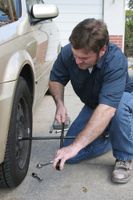
Flat tires happen to all of us; having the skills to change them is essential for adulthood. Even if you count on using a roadside service or a car repair shop when this situation occurs, you never know when you’ll be in an isolated situation where this isn’t possible. Here’s how to do this in an easy, seven-step process.
A Car Repair Shop Explains 7 Simple Steps for Changing a Flat Tire
1. Find a Safe Location
If the wheel starts to make flapping sounds while you’re driving, it’s likely that you’ve just blown a tire. The first step is to find a safe place where you can have enough room to work. Ideally, you should look for a flat, paved surface where you’ll be a good distance from passing vehicles. After you park, turn on the hazard lights and place reflective triangles to make other drivers aware of you.
2. Loosen the Lug Nuts
The next step is to remove the hubcap; then, loosen—but not totally remove—the lug nuts. To do this, you’ll need to use the lug wrench located in your trunk. It’s smart to keep all the necessary tools in one box and check from time-to-time that you’re fully prepared for emergencies.
3. Jack Up the Car
Put on your car’s parking brake, place blocks under the wheels to ensure the vehicle won’t roll, then get out the jack. Using the owner’s manual to guide you, position the jack under the correct spot; then, pump it up till the flat is about six inches off the ground. Remember: jacks can fail, so never place any part of yourself beneath the elevated vehicle.
4. Remove the Lug Nuts & Wheel
 Once the car is off the ground, it’s time to remove the lug nuts the rest of the way. Place them somewhere you won’t lose them, like in the hubcap. Then, lift the flat wheel off the car. Be careful not to injure yourself since the wheel may be heavier than you expect.
Once the car is off the ground, it’s time to remove the lug nuts the rest of the way. Place them somewhere you won’t lose them, like in the hubcap. Then, lift the flat wheel off the car. Be careful not to injure yourself since the wheel may be heavier than you expect.
5. Install the New Wheel
With the old wheel out of the way, get out the spare and lift it into position. It should align with the exposed lug bolts. After this, use your fingers to hand-tighten the nuts. However, don’t secure them with the wrench, yet!
6. Lower the Car
With the new wheel installed, you can use the jack to lower your car back down. After stowing the jack away, use the lug wrench to tighten the nuts the rest of the way. This time, ensure they’re good and tight. A loose lug nut can cause disaster.
7. Drive to a Repair Shop
Using your pressure gauge, check to make sure the spare is adequately pumped up. If you don’t have the necessary equipment, drive to the nearest gas station and use their gauge and pump to do this before continuing the trip. Then you’re all finished! Keep in mind that you shouldn’t drive on the spare for too long, or at high speeds; you’ll want to get to a car repair shop as quickly as possible.
Looking for help with everything from oil changes to auto electrical repairs around the East St. Paul/Maplewood, MN, areas? The experts at Stillwater Auto Clinic can care for your needs. Trained to handle a variety of services, their expert team will have your vehicle back on the road as soon as possible—they’ve built their reputation for excellence over the past four decades. Learn more about the car repair shop today by visiting them online or calling (651)351-7188.
About the Business
Have a question? Ask the experts!
Send your question

